
The first red-fingered anglerfish, Porophryne erythrodactylus, I ever saw.
Monday 26 February 2018
I was recently reading through Rachel Arnold's (Arnold et al, 2014) paper describing the red-fingered anglerfish, Porophryne erythrodactylus, when I realised I have pretty much seen all the colour morphs shown in the paper. It is truly remarkable how much variation there is in colour patterns in this species and also how well these colours help them camouflage with their surroundings.
I saw my first red-fingered anglerfish in January 2011. It was a grey colour morph that was pointed out to me by another diver at The Leap, Kurnell. The camouflage was so good I didn't even recognise it as a fish at first. It looked exactly like a grey sponge, compete with pores. It was only when I moved to a different angle that I saw the eyes and then it was obvious to me.

The first red-fingered anglerfish, Porophryne erythrodactylus, I ever saw.
At the time they wasn't called red-fingered anglerfish and they had no scientific name. They were called Botany Bay anglerfish or even Bare Island anglerfish as many were initially found at Bare Island.
It was another 8 months before I'd see my second, also a grey morph, also pointed out by another diver, and also at The Leap. Six months later again I found a grey colour morph on my own, at The Leap. By early 2013 I was seeing these anglerfish quite regularly. Interestingly, I was seeing all of these at Kurnell and all of them were grey.

A grey red-fingered anglerfish, Porophryne erythrodactylus, at Kurnell in December 2012.
In September 2013, I saw my first orange and red colour morph. It was one pointed out to me by a fellow diver at Kurnell. I saw this same individual over a few weeks once I worked out I could recognise individuals by the cutaneous appendages. I then found another on my own orange and red colour morph, also at Kurnell. My buddy and I found a few more and we also saw a number of other grey morphs.
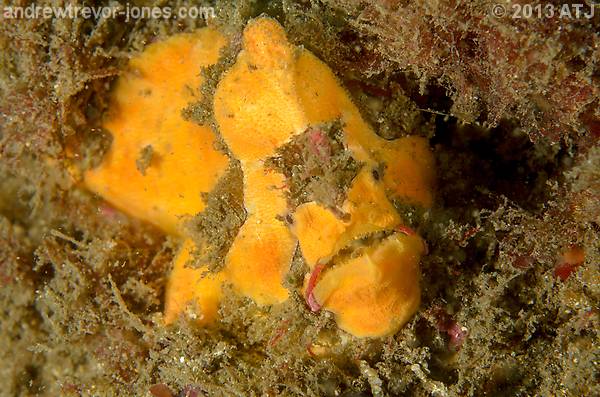
The first orange red-fingered anglerfish, Porophryne erythrodactylus, I saw at Kurnell in September 2013.
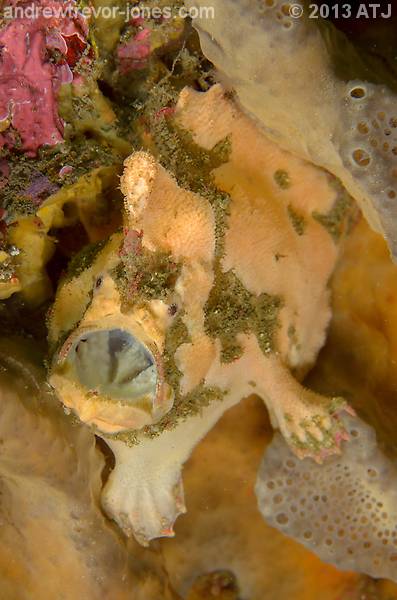
One of a number of orange red-fingered anglerfish, Porophryne erythrodactylus, I saw at Kurnell in late 2013. This one is more of a salmon colour.
In late 2013, I was shown some individuals on the eastern side Bare Island. One of these was a white and grey colour morph that isn't described in the paper, another was the pink colour morph, yet another was the yellow colour morph and there was an orange and red colour morph similar to the ones I'd seen at Kurnell.
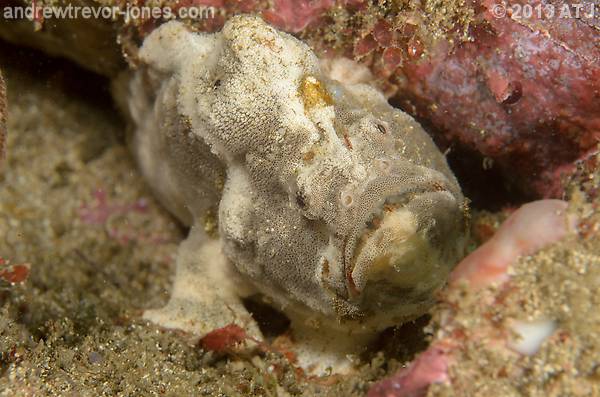
A white/grey red-fingered anglerfish, Porophryne erythrodactylus, at Bare Island in November 2013.
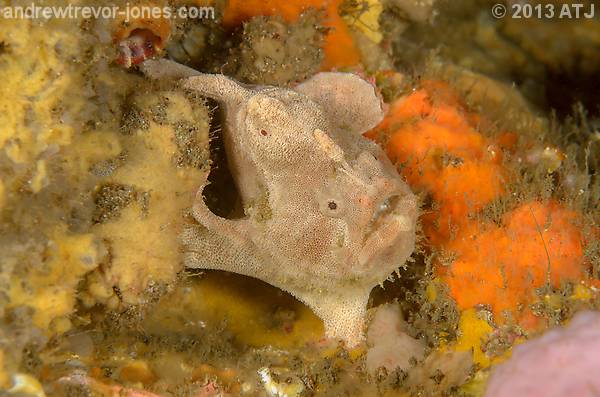
A pink red-fingered anglerfish, Porophryne erythrodactylus, at Bare Island in November 2013.

A yellow red-fingered anglerfish, Porophryne erythrodactylus, at Bare Island in November 2013.

Another white/grey red-fingered anglerfish, Porophryne erythrodactylus, at Bare Island in November 2013.
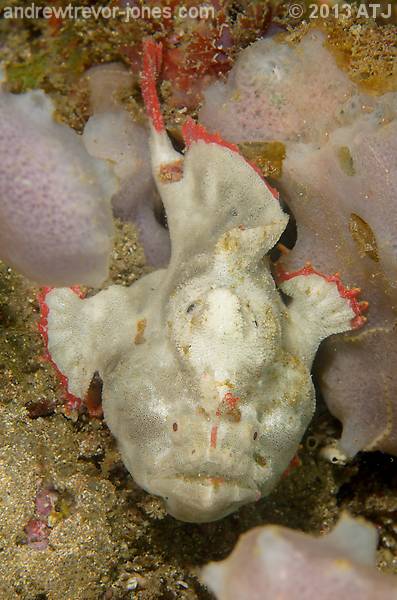
Yet another white/grey red-fingered anglerfish, Porophryne erythrodactylus, at Bare Island in December 2013.
Throughout 2014, I saw quite a few orange colour morphs at Kurnell, with the occasional grey morph.
In October 2014, Rachel Arnold, Rob Harcourt and Ted Pietsch published their paper describing these anglerfish as a new species. They even created a new genus for it because it was so different from other species of anglerfishes. The genus they created is Porophryne. The name is derived from the Greek, Poro and phryne. Poro means "bearing pores", referring to the allusion of the "spots" on the head and body of most specimens, as well as their tendency to associate with sponges (Porifera). phryne means "toad" and is frequently uses as a suffix for genera in the order Lophiiformes. The species name they gave it is erythrodactylus, also from the Greek, erythro meaning "red" and dactylus meaning "fingers" or "toes", referring to the red tips to the pectoral fin rays as well as red along the margins of most of the other fins.
It is worth noting that while the paper describing this species calls them "frogfish", I continue to use "anglerfish" because this is the name used in Australia for any member of the family Antennariidae. In Australia, frogfishes are members of the family Batrachoididae.
The authors describe "two distinct color phases", separating them into:
Most the grey individuals I have seen have had no or only very small patches of the cutaneous appendages, however, I have seen other colours with the naked black spots and almost no cutaneous appendages.

Here is an orange individual at Kurnell in December 2014 showing the pattern of cutaneous appendages.
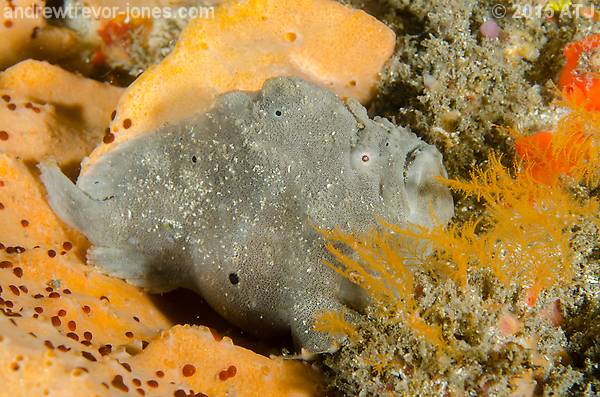
Here is an grey individual at Henry Head in August 2015 showing the naked black spots and absence of cutaneous appendages.
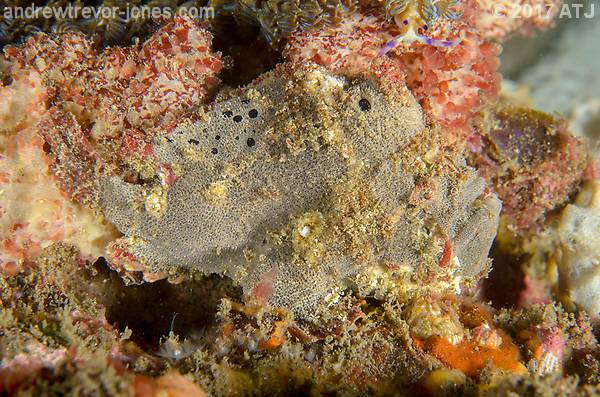
Here is an grey individual at Kurnell in January 2017 showing the both naked black spots and some cutaneous appendages.
From 2014 through to mid-2017 I was seeing both orange and grey red-fingered anglerfish regularly. From mid-2017, I started to see a lot more variation in colouration as well as the amount of cutaneous appendages on some individuals. One individual, which I would have to describe as orange was so covered in cutaneous appendages that it was difficult to see any colour at all.
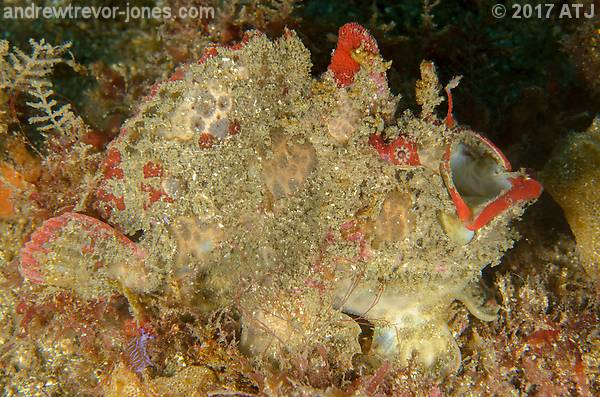
This orange individual at Kurnell in July 2017 has so many cutaneous appendages that there is barely any colour showing.

This salmon (pink) individual at Kurnell in July 2017 has almost no cutaneous appendages at all.
Red-fingered anglerfish have mostly been found in the Sydney region and in particular around Botany Bay. There are some confirmed observations from as far south as Jervis Bay so they may have a wider distribution.
In September 2017 I saw my first white individual, although it was more of an off white. Unlike the white/grey individuals I'd seen at Bare Island, this one (and the subsequent ones I have seen) have a lot of cutaneous appendages. I have seen a number more of the white individuals since then.
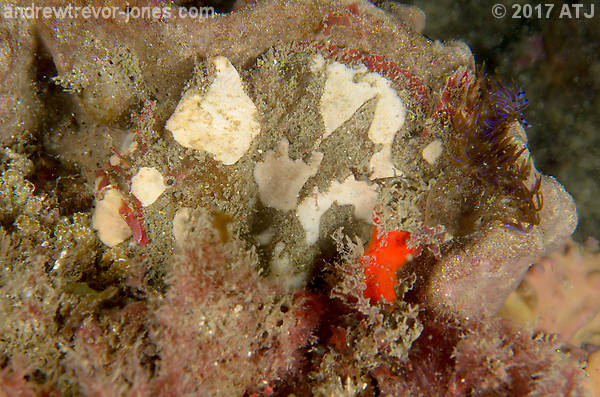
The first white individual I saw at Kurnell in September 2017.
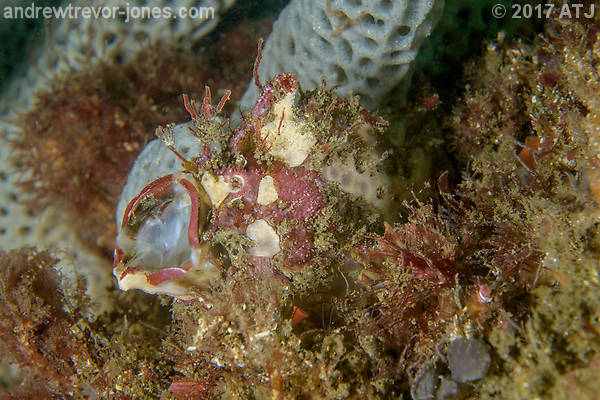
Another white individual at Kurnell in November 2017. This one is actually pale yellow and has a lot of pink around the head.
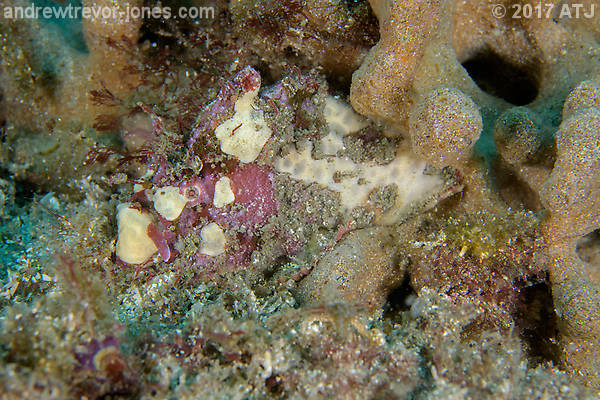
This is the same individual as above but in December 2017. The patterning on the side of the body perfectly matched the sponge in the previous photograph but not in the current one.
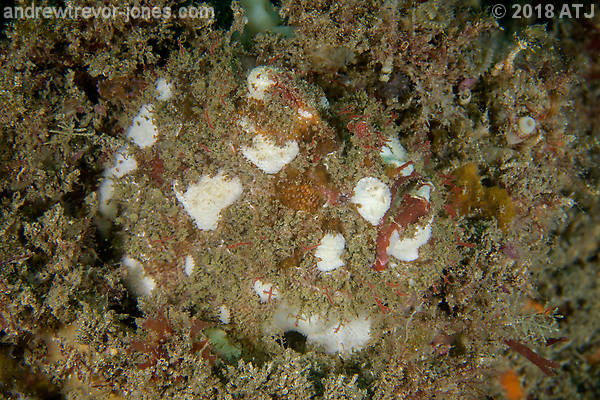
Another white individual at Kurnell in January 2018 with vast amount of cutaneous appendages.

A yellow individual at Kurnell in January 2018 with cutaneous appendages.
Just when I think I have seen all the possible colours, I see some new ones.

An orange individual at Kurnell in January 2018 with basically no cutaneous appendages.
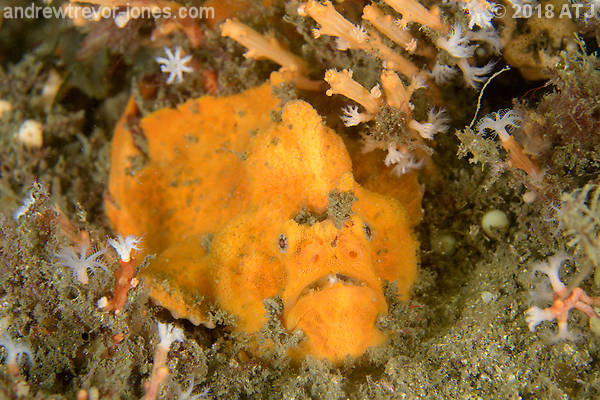
An orange individual at Kurnell in January 2018 with barely any cutaneous appendages.

A yellow individual at Kurnell in January 2018 with a lot of cutaneous appendages.

An orange individual at Kurnell in February 2018 with a lot of pink.
As my photographs have shown, there is great diversity in the colouration and patterning of red-fingered anglerfish. I have seen photographs by other people that show even more colours and patterns than I have shown here or seen myself. They are amazing fish with amazing camouflage. They are sometimes easy to spot and may stay in the same spot for days to weeks but then they will seem to disappear. I wonder if they are still around but have just found a better place to hide.
As long as I dive around Botany Bay I will continue to look out for these fantastic fish. I will never tire of finding and photographing them.
Arnold R.J., Harcourt R. and Pietsch T.W. 2014. A New Genus and Species of the Frogfish Family Antennariidae (Teleostei:Lophiiformes: Antennarioidei) from New South Wales, Australia, with a Diagnosis and Key to the Genera of the Histiophryninae. Copeia 2014 No. 3:534-539.
Please leave Feedback if you have any comments or questions about this blog entry.